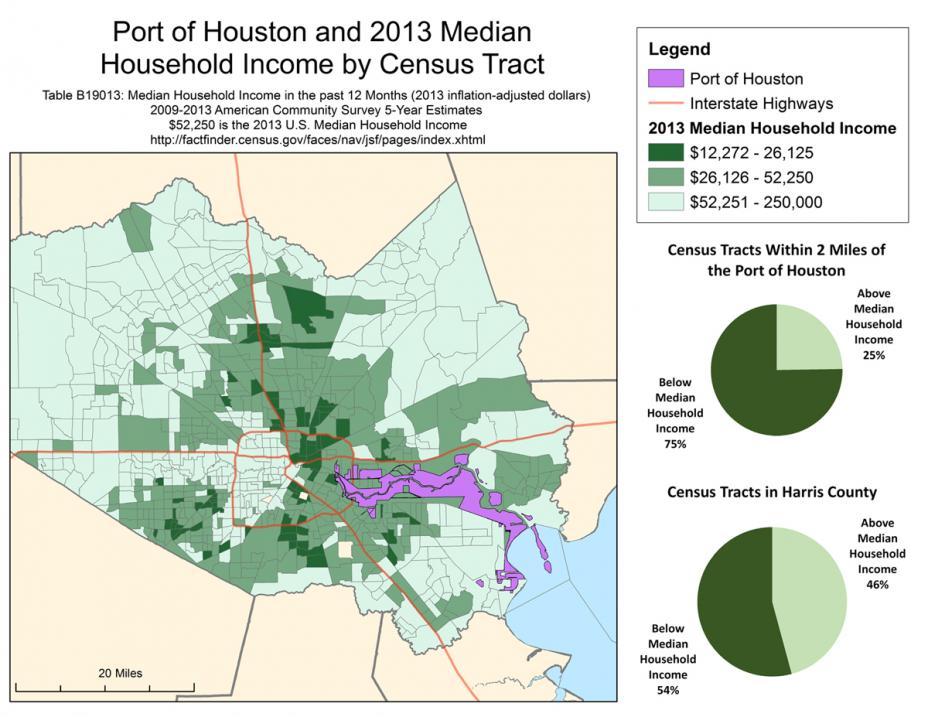Ports Primer: 4.1 Port Impacts to Local Communities
Ports support and benefit local, regional and national economies through their role in creating jobs and transporting goods. They can also partner with communities to offer workforce development programs, protect the environment and coordinate on land use planning to incorporate community amenities.
However, ports can also create potential challenges for near-port communities who are disproportionately impacted by port operations and related transportation systems. In addition, while ports are major economic engines for local, regional, and national economies, these economic benefits may not be equitably distributed. The near-port communities may not be receiving a fair share of the economic benefits that are flowing to the region.
Additional detail examining potential impacts to near-port communities related to these topics is provided in the Primer:
- Land Use and Transportation – Section 5.0
- Local and Regional Economy – Section 6.0
- Environmental Impacts – Section 7.0
Note that near-port communities can include Native American tribal groups. Tribes are sovereign nations and may have associated treaty rights that influence port-community relations.
Addressing Environmental Justice
While communities across the country benefit from access to consumer goods, near-port communities bear a disproportionate burden from the environmental impacts of these activities. Ports and related industry operations frequently impact communities of color and low-income communities, resulting in environmental justice concerns.
According to EPA’s Office of Environmental Justice, “environmental justice […] will be achieved when everyone enjoys the same degree of protection from environmental and health hazards and equal access to the decision-making process to have a healthy environment in which to live, learn, and work.”
Executive Order 12898 requires that federal agencies shall, to the greatest extent practicable, identify and address disproportionately high and adverse human health or environmental impacts from their programs, policies, and activities. This obligation extends beyond NEPA reviews to activities such as permitting and rulemaking.
For more information:
Reducing Air Emissions Associated with Goods Movement
Environmental Justice
Executive Order 12898
In 1994, President Bill Clinton issued Executive Order (E.O.) 12898 - Federal Actions to Address Environmental Justice in Minority Populations and low-Income Populations. The purpose of the order is to “focus federal attention on the environmental and human health effects of federal actions on minority and low-income populations with the goal of achieving environmental protection for all communities.” Ports often will be involved with federal actions that fall under E.O.12898’s mandate to identify and address disproportionately high and adverse impacts. Federal actions at ports are valuable opportunities for community engagement and consideration of environmental justice.
For more information: Executive Order 12898
Public Communication
An important way to involve community members in port decisions is through communication about upcoming port authority meetings, newly proposed infrastructure projects, notices of environmental impact documents, port commission meeting minutes, etc. Some ports have websites on which they post agendas, minutes and videos of meetings. Other ports provide communications primarily via email upon request.
Another way that ports can be responsive to the needs of near-port communities is to have a clear point of contact for community issues and complaints. Additionally, having a process or structure in place for receiving community input on port operations and projects that impact environmental conditions can be important for effective engagement.
For examples of ports who provide more extensive communications online:
Port of Long BeachExit
Port of Los AngelesExit
Socioeconomic Mapping
Maps can be used as a tool to examine the distribution of income levels and residents of color around ports. For examples, click the Map 1-4 buttons.
EPA’s EJ Screen tool can assist communities with mapping data related to near-port communities. EJ screen is an online environmental justice (EJ) mapping tool that provides both summary and detailed information at the Census block group level or a user-defined area for both demographic and environmental indicators. More information can be found in Appendix 2.
For more information: EJ Screen Map
Tools for Influencing Port Planning and Operations
Communities can employ a range of strategies for getting involved in port-related issues, including to:
- Stay informed
- Comment on documents
- Join an advisory group
- Educate the community
- Apply for community funding
- Pilot a new program
- Understand jurisdiction and decision-making processes
- Negotiate for community needs
- Lobby elected officials
- Litigate to address community needs
- Engage Board of Directors/Commissioners
For example, one tool for commenting on decision documents is the National Environmental Policy Act (NEPA). NEPA requires federal agencies to analyze the environmental impacts of federal construction projects, permit approvals, and funding decisions and to consider reasonable alternatives to those actions. Members of the public can participate in the NEPA process during public comment periods.
For more information, see the Environmental Impacts section. Additionally, use of existing studies and citizen science (sometimes known as community science) is discussed in the Tools and Resources section of this Primer.















